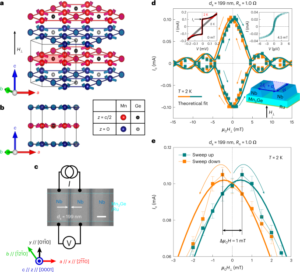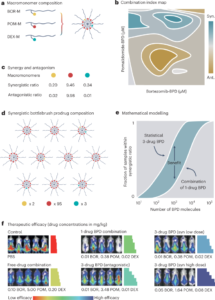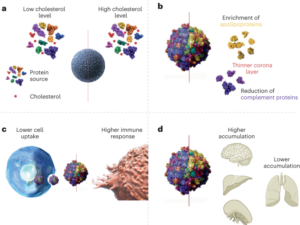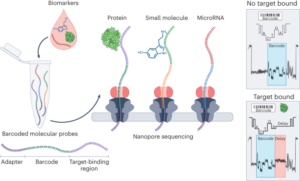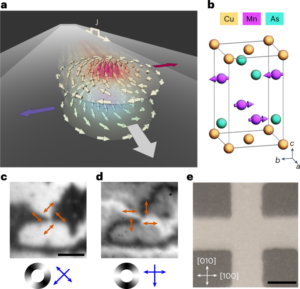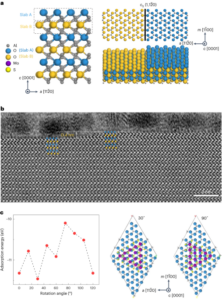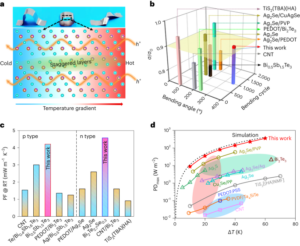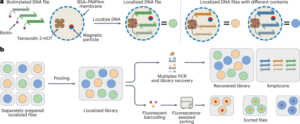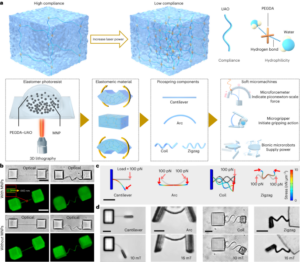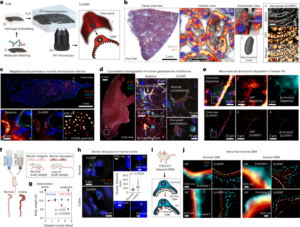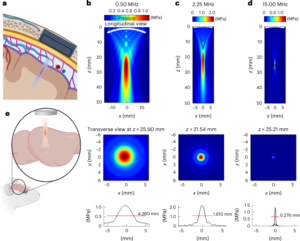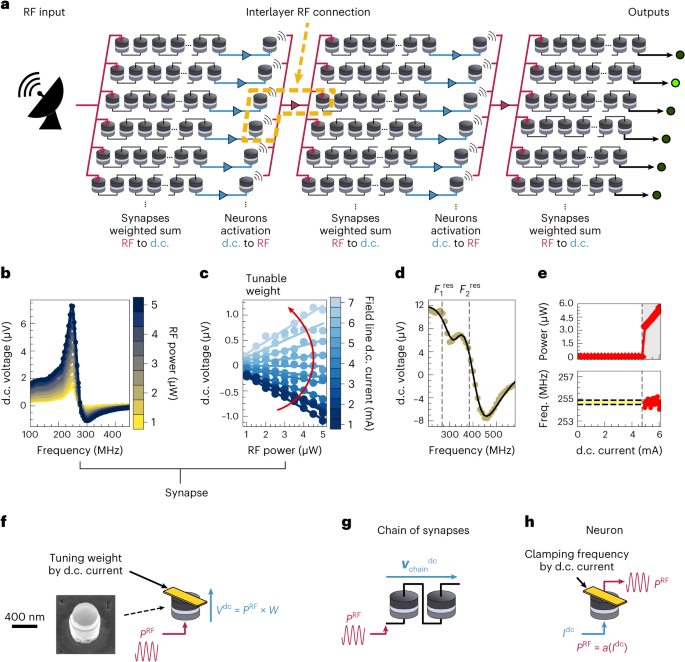
LeCun, Y., Bengio, Y. & Hinton, G. Deep learning. Nature 521, 436–444 (2015).
Christensen, D. V. et al. 2022 roadmap on neuromorphic computing and engineering. Neuromorphic Comput. Eng. 2, 022501 (2022).
Grollier, J. et al. Neuromorphic spintronics. Nat. Electron. 3, 360–370 (2020).
Worledge, D. C. Spin-Transfer-Torque MRAM: the next revolution in memory. In 2022 IEEE International Memory Workshop (IMW) 1–4 (IEEE, 2022).
Safranski, C., Sun, J. Z. & Kent, A. D. A perspective on electrical generation of spin current for magnetic random access memories. Appl. Phys. Lett. 120, 160502 (2022).
Lequeux, S. et al. A magnetic synapse: multilevel spin-torque memristor with perpendicular anisotropy. Sci. Rep. 6, 31510 (2016).
Kurenkov, A. et al. Artificial neuron and synapse realized in an antiferromagnet/ferromagnet heterostructure using dynamics of spin–orbit torque switching. Adv. Mater. 31, 1900636 (2019).
Chen, R. et al. Nanoscale room-temperature multilayer skyrmionic synapse for deep spiking neural networks. Phys. Rev. Appl. 14, 014096 (2020).
Song, K. M. et al. Skyrmion-based artificial synapses for neuromorphic computing. Nat. Electron. 3, 148–155 (2020).
Mansueto, M. et al. Spintronic memristors for neuromorphic circuits based on the angular variation of tunnel magnetoresistance. Nanoscale 13, 11488–11496 (2021).
Zhang, X. et al. Spin-torque memristors based on perpendicular magnetic tunnel junctions for neuromorphic computing. Adv. Sci. 8, 2004645 (2021).
Xu, J.-W. et al. A quantum material spintronic resonator. Sci. Rep. 11, 15082 (2021).
Kiraly, B., Knol, E. J., van Weerdenburg, W. M. J., Kappen, H. J. & Khajetoorians, A. A. An atomic Boltzmann machine capable of self-adaption. Nat. Nanotechnol. 16, 414–420 (2021).
Leroux, N. et al. Hardware realization of the multiply and accumulate operation on radio-frequency signals with magnetic tunnel junctions. Neuromorphic Comput. Eng. https://doi.org/10.1088/2634-4386/abfca6 (2021).
Monalisha, P., Kumar, A. P. S., Wang, X. R. & Piramanayagam, S. N. Emulation of synaptic plasticity on a cobalt-based synaptic transistor for neuromorphic computing. ACS Appl. Mater. Interfaces 14, 11864–11872 (2022).
Torrejon, J. et al. Neuromorphic computing with nanoscale spintronic oscillators. Nature 547, 428–431 (2017).
Prychynenko, D. et al. Magnetic skyrmion as a nonlinear resistive element: a potential building block for reservoir computing. Phys. Rev. Appl. 9, 014034 (2018).
Borders, W. A. et al. Integer factorization using stochastic magnetic tunnel junctions. Nature 573, 390–393 (2019).
Tsunegi, S. et al. Physical reservoir computing based on spin torque oscillator with forced synchronization. Appl. Phys. Lett. 114, 164101 (2019).
Koo, M. et al. Distance computation based on coupled spin-torque oscillators: application to image processing. Phys. Rev. Appl. 14, 034001 (2020).
Zahedinejad, M. et al. Two-dimensional mutually synchronized spin Hall nano-oscillator arrays for neuromorphic computing. Nat. Nanotechnol. 15, 47–52 (2020).
Ababei, R. V. et al. Neuromorphic computation with a single magnetic domain wall. Sci. Rep. 11, 15587 (2021).
Watt, S., Kostylev, M., Ustinov, A. B. & Kalinikos, B. A. Implementing a magnonic reservoir computer model based on time-delay multiplexing. Phys. Rev. Appl. 15, 064060 (2021).
Mazza, L. et al. Computing with injection-locked spintronic diodes. Phys. Rev. Appl. 17, 014045 (2022).
Zahedinejad, M. et al. Memristive control of mutual spin Hall nano-oscillator synchronization for neuromorphic computing. Nat. Mater. 21, 81–87 (2022).
Romera, M. et al. Vowel recognition with four coupled spin-torque nano-oscillators. Nature 563, 230–234 (2018).
Romera, M. et al. Binding events through the mutual synchronization of spintronic nano-neurons. Nat. Commun. 13, 883 (2022).
Finocchio, G. et al. Perspectives on spintronic diodes. Appl. Phys. Lett. 118, 160502 (2021).
Siafarikas, D. & Volakis, J. L. Toward direct RF sampling: implications for digital communications. IEEE Microw. Mag. 21, 43–52 (2020).
Farley, B., McGrath, J. & Erdmann, C. An all-programmable 16-nm RFSoC for digital-RF communications. IEEE Micro 38, 61–71 (2018).
Leroux, N. et al. Radio-frequency multiply-and-accumulate operations with spintronic synapses. Phys. Rev. Appl. 15, 034067 (2021).
Tulapurkar, A. A. et al. Spin-torque diode effect in magnetic tunnel junctions. Nature 438, 339–342 (2005).
Slavin, A. & Tiberkevich, V. Nonlinear auto-oscillator theory of microwave generation by spin-polarized current. IEEE Trans. Magn. 45, 1875–1918 (2009).
Wright, L. G. et al. Deep physical neural networks trained with backpropagation. Nature 601, 549–555 (2022).
Yoon, Y. H., Khan, S., Huh, J. & Ye, J. C. Efficient B-mode ultrasound image reconstruction from sub-sampled RF data using deep learning. IEEE Trans. Med. Imaging 38, 325–336 (2019).
Dai, M., Li, S., Wang, Y., Zhang, Q. & Yu, J. Post-processing radio-frequency signal based on deep learning method for ultrasonic microbubble imaging. Biomed. Eng. Online 18, 95 (2019).
Besler, E., Wang, Y. C. & Sahakian, A. V. Real-time radiofrequency ablation lesion depth estimation using multi-frequency impedance with a deep neural network and tree-based ensembles. IEEE Trans. Biomed. Eng. 67, 1890–1899 (2020).
Merchant, K., Revay, S., Stantchev, G. & Nousain, B. Deep learning for RF device fingerprinting in cognitive communication networks. IEEE J. Sel. Top. Signal Process. 12, 160–167 (2018).
Lien, J. et al. Soli: ubiquitous gesture sensing with millimeter wave radar. ACM Trans. Graph. 35, 142 (2016).
Basak, S., Rajendran, S., Pollin, S. & Scheers, B. Drone classification from RF fingerprints using deep residual nets. In 2021 International Conference on COMmunication Systems & NETworkS (COMSNETS) 548–555 (IEEE, 2021).
USRP X310 High-Performance Software Defined Radio https://www.ettus.com/all-products/x310-kit/ (Ettus Research).
Compare 10 Series Graphics Cards, GeForce https://www.nvidia.com/en-in/geforce/products/10series/compare/ (NVIDIA).
Chao, X., Jamali, M. & Wang, J.-P. Scaling effect of spin-torque nano-oscillators. AIP Adv. 7, 056624 (2017).
Marković, D., Mizrahi, A., Querlioz, D. & Grollier, J. Physics for neuromorphic computing. Nat. Rev. Phys. 2, 499–510 (2020).
Dussaux, A. et al. Large amplitude spin torque vortex oscillations at zero external field using a perpendicular spin polarizer. Appl. Phys. Lett. 105, 022404 (2014).
Tsunegi, S. et al. High emission power and Q factor in spin torque vortex oscillator consisting of FeB free layer. Appl. Phys. Express 7, 063009 (2014).
Choi, J.-G. et al. Voltage-driven gigahertz frequency tuning of spin Hall nano-oscillators. Nat. Commun. 13, 3783 (2022).
Martins, L. et al. Non-volatile artificial synapse based on a vortex nano-oscillator. Sci. Rep. 11, 16094 (2021).
Jiang, S. et al. Reduced spin torque nano-oscillator linewidth using He+ irradiation. Appl. Phys. Lett. 116, 072403 (2020).
Divinskiy, B., Urazhdin, S., Demokritov, S. O. & Demidov, V. E. Controlled nonlinear magnetic damping in spin-Hall nano-devices. Nat. Commun. 10, 5211 (2019).
Sethi, P. et al. Compensation of anisotropy in spin-Hall devices for neuromorphic applications. Phys. Rev. Appl. 19.6, 064018 (2023).
Jenkins, A. S., Alvarez, L. S. E., Freitas, P. P. & Ferreira, R. Digital and analogue modulation and demodulation scheme using vortex-based spin torque nano-oscillators. Sci. Rep. 10, 11181 (2020).
Jung, S. et al. A crossbar array of magnetoresistive memory devices for in-memory computing. Nature 601, 211–216 (2022).
Craven, M. P., Curtis, K. M. & Hayes-Gill, B. R. Frequency division multiplexing in analogue neural network. Electron. Lett. 27, 918–920 (1991).
Leroux, N. et al. Convolutional neural networks with radio-frequency spintronic nano-devices. Neuromorphic Comput. Eng. 2, 034002 (2022).
Noh, S. et al. Spin dynamics in ferromagnetic resonance for nano-sized magnetic dot arrays: metrology and insight into magnetization dynamics. IEEE Trans. Magn. 47, 2387–2390 (2011).
Litvinenko, A. et al. Ultrafast GHz-range swept-tuned spectrum analyzer with 20 ns temporal resolution based on a spin-torque nano-oscillator with a uniformly magnetized ‘free’ layer. Nano Lett. 22, 1874–1879 (2022).
Kurokawa, Y. et al. Ultra-wide-band millimeter-wave generator using spin torque oscillator with strong interlayer exchange couplings. Sci. Rep. 12, 10849 (2022).
Bonetti, S., Muduli, P., Mancoff, F. & Åkerman, J. Spin torque oscillator frequency versus magnetic field angle: the prospect of operation beyond 65 GHz. Appl. Phys. Lett. 94, 102507 (2009).
Khymyn, R. et al. Ultra-fast artificial neuron: generation of picosecond-duration spikes in a current-driven antiferromagnetic auto-oscillator. Sci. Rep. 8, 15727 (2018).
Chakravarty, A. et al. Supervised learning of an opto-magnetic neural network with ultrashort laser pulses. Appl. Phys. Lett. 114, 192407 (2019).
Scellier, B. & Bengio, Y. Equilibrium propagation: bridging the gap between energy-based models and backpropagation. Front. Comput. Neurosci. 11, 24 (2017).
Akiba, T., Sano, S., Yanase, T., Ohta, T. & Koyama, M. Optuna: a next-generation hyperparameter optimization framework. In Proceedings of the 25th ACM SIGKDD International Conference on Knowledge Discovery & Data Mining 2623–2631 (Association for Computing Machinery, 2019).
- SEO Powered Content & PR Distribution. Get Amplified Today.
- PlatoData.Network Vertical Generative Ai. Empower Yourself. Access Here.
- PlatoAiStream. Web3 Intelligence. Knowledge Amplified. Access Here.
- PlatoESG. Automotive / EVs, Carbon, CleanTech, Energy, Environment, Solar, Waste Management. Access Here.
- BlockOffsets. Modernizing Environmental Offset Ownership. Access Here.
- Source: https://www.nature.com/articles/s41565-023-01452-w
- ][p
- 1
- 10
- 11
- 12
- 13
- 14
- 15%
- 16
- 17
- 19
- 20
- 2005
- 2008
- 2011
- 2014
- 2015
- 2016
- 2017
- 2018
- 2019
- 2020
- 2021
- 2022
- 2023
- 22
- 23
- 24
- 25
- 26
- 27
- 28
- 30
- 31
- 32
- 33
- 36
- 39
- 40
- 46
- 49
- 50
- 51
- 60
- 65
- 7
- 8
- 9
- a
- access
- Accumulate
- ACM
- AL
- alvarez
- an
- and
- Angular
- Application
- applications
- Array
- article
- artificial
- AS
- Association
- At
- b
- based
- between
- Beyond
- binding
- Block
- bridging
- Building
- by
- capable
- Cards
- classification
- click
- cognitive
- Communication
- Communications
- Compensation
- computation
- computer
- computing
- Conference
- Connections
- Consisting
- control
- controlled
- coupled
- Current
- data
- deep
- deep learning
- deep neural network
- defined
- depth
- device
- Devices
- digital
- direct
- discovery
- distance
- Division
- domain
- DOT
- drone
- dynamics
- e
- E&T
- effect
- efficient
- element
- emission
- Engineering
- Equilibrium
- Ether (ETH)
- events
- exchange
- external
- factor
- Feb
- field
- Fingerprinting
- For
- four
- Framework
- Free
- Frequency
- from
- gap
- generation
- generator
- gesture
- graph
- graphics
- Hall
- Hardware
- High
- high-performance
- http
- HTTPS
- Hyperparameter optimization
- IEEE
- image
- Imaging
- implementing
- implications
- in
- insight
- International
- into
- knowledge
- large
- laser
- layer
- learning
- li
- LINK
- machine
- machinery
- Mag
- Magnetic field
- material
- Memories
- Memory
- method
- Metrology
- model
- models
- mutual
- mutually
- nanotechnology
- Nature
- Nets
- network
- networks
- Neural
- neural network
- neural networks
- next
- next-generation
- Nvidia
- of
- on
- operation
- Operations
- optimization
- perspective
- perspectives
- physical
- Physics
- plato
- Plato Data Intelligence
- PlatoData
- post-processing
- potential
- power
- process
- processing
- propagation
- prospect
- Quantum
- R
- radar
- Radio
- random
- real-time
- realization
- realized
- recognition
- Reduced
- research
- Resolution
- resonance
- Revolution
- roadmap
- s
- scaling
- scheme
- Scholar
- SCI
- Series
- Signal
- signals
- single
- Software
- Spectrum
- spikes
- Spin
- strong
- Sun
- supervised learning
- Synapse
- Synapses
- synchronization
- Systems
- T
- The
- theory
- Through
- to
- top
- toward
- trained
- tunnel
- ubiquitous
- Ultrasonic
- ultrasound
- using
- Versus
- W
- Wall
- Wave
- with
- workshop
- X
- ye
- zephyrnet
- zero

